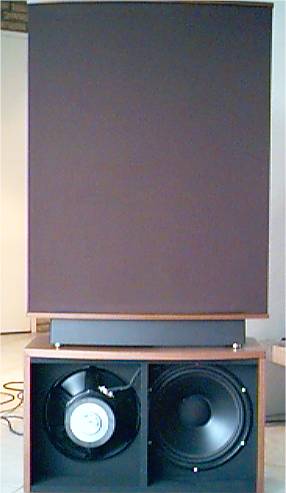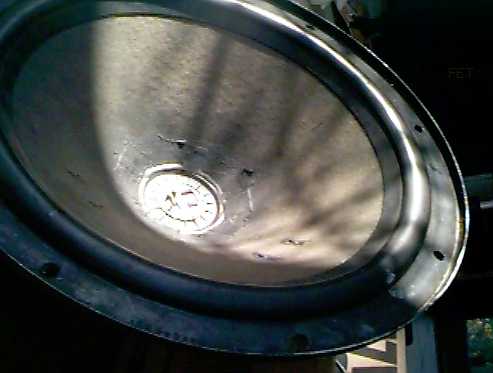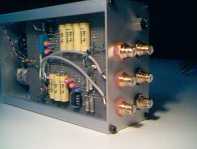
Fig 1. This sub is driven by a Quad 405.
Speakers are in series. |
Anti-malaria
drones. A marvelous project to combat the spreading
of malaria!
Guido Welter, Richard Mukabana and Bart Knols. The Contrapunt, a dipole sub woofer for the Quad ESL-63The ESL-63, though an excellent loudspeaker, cannot produce the full contra octave and cannot produce sound levels higher than 96 dB. The contrapunt is designed to cover these aspects, but when these extremes are not met the use of the sub woofer should be inaudible when it is compared to the ESL63 full range. For me It was quite a discovery that it is possible to build a sub without an enclosure. Compared to normal sub woofers there could be several specific advantages with dipoles. Normal subs with an enclosure excite many more room modes, due to their omnidirectional character. This can lead to an uneven frequency response at the listening position. In contrast, due to the directional nature of a dipole there are no standing waves to the ceiling and side walls. The bass of the dipole is deep because the resonance frequency of the woofer is not shifted upwards by an enclosure. Energy is transmitted without the delay and the back-lash that is caused by a box. Bass energy build up is immediately. I have given this sub a name, the Contrapunt. It can be used with speakers for the upper range that can be crossed at 110Hz. For every channel a sub woofer should be used. Combined with a Quad ESL-63, the ESL can play up to 10dB louder and the lower bass range is extended. An extra advantage of the Contrapunt is that when it is used with the Quads, the dipole frequency characteristic of the combination of the ESL and the sub woofer will be the same on both sides. The design of the sub woofer is simple, but at the expense of an extra amplifier and an electronic crossover/correction filter. Measured frequency range is 24 to 110Hz within 3dB. They should be placed at least one meter before the rear wall. In my living room they have 4 meters free space behind. For a excellent briefing on dipole sub woofer theory see Brian Steele's subwoofer page or Sigfried Linkwitz' elaborate DIY speaker building page. SoundThe quality of a dipole sub is different from what most listeners anticipated as the sound of an open bass system. Also for me. The sub is precise, no matter if it has to generate pressure and attack for electronic dance music or to reveal the delicacy of a slap bass. Bass doesn't need time to build up, it is very well damped, better than when a enclosure is used. Low-frequency tones are reproduced life-like. The combination of the Quad ESL-63 and the sub woofer shows in symphonic works precise positioning and discrimination of instruments, and a great dynamic range while maintaining an impressive reproduction of sound stage and space. Don't be fooled, the sound pressure with 2 subs in a 50m2 living room is 100dB at 31,2 Hz. The dipole sub doesn't add coloration. When the extremes this dipole subwoofer is designed for are not existent, i.e. SPL below 96dB and no content below 40Hz, switching off the contrapunt and switching on the ESL-63 to full range is (nearly) inaudible. When it is not needed it is not there. Design considerationsA specific characteristic of a dipole is the cancellation frequency that is determined by the size of the baffle. A compensation of +6dB/octave is needed below the cancellation frequency of the baffle, which starts when the shortest path between the positive front and the negative back wave is 0.5 wave length. This quality is also the cause of the directional radiation pattern that looks like the figure 8, giving less standing waves in the listening room than a traditional woofer design. A lot of acoustic power is principally lost with a dipole. The size of the folded baffle is a compromise between efficiency and the higher frequency at which the dipole becomes a comb filter. The size of the baffle is chosen to let it work solely in the 6dB decrease region. The region in which the dipole woofer reacts as a comb filter is well above the crossover frequency. The woofers should be able to move a lot of air to compensate for the acoustic loss. Technical backgroundsThe resonance frequency of the
drivers should be below the lowest note to be produced.
Motional Feedback WoofersWhen one is used to the undistorted clean bass
response of the Quad's, sometimes -the human ear is not very
sensitive to harmonic distortion in the bass region- the need
is felt for a further reduction of harmonic distortion of the sub
woofer. This can be accomplished by using a servo controlled
woofer. Distortion can become below 3% at high levels. On the
picture is in the middle the acceleration element of a Philips 12"
MFB woofer. In a dipole the MFB is less advantageous than in a
closed box. The Shiva or AE woofers already have a very low free
air distortion. Geert Meddens, this page started in sept. 1999. |
|||||||||||||||
|
Fig. 2 The electronic crossover and correction unit. Filter Scheme and Graphs
Although the slope of the high pass is electrically 12dB/oct, the acoustic slope is determined by the combination ESL and filter. The same applies to the acoustic combination of the woofer+filter. The slopes are carefully tailored with the characteristics of the speakers to give a flat frequency response. In the crossover region the phase response of the low pass (subwoofer+filter) and high pass (ESL+filter) are nearly the same (20 degree difference). Two other features are incorporated in the filter. The characteristic of the subsonic high pass filter at 20Hz has also some compensation for the fall off due to the Q factor of the woofer. The high pass section in front of the ESL gives the region between 150-200Hz a lift of 1.6dB to compensate for a nearly inaudible flaw in the frequency characteristic of the ESL. Although the filter seems quite normal, it is carefully designed and tested to function for the combination of an ESL63 with this dipole sub. A digital filter with an ADAU1701 DSP is also tested. With the PGA2311 analog volume control placed behind the filter this gave very good results. In this way the filter could always work at the maximum bit size! 
| ||||||||||||||||





